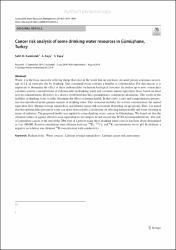Cancer risk analysis of some drinking water resources in Gumuhane, Turkey
Access
info:eu-repo/semantics/closedAccessDate
2019Access
info:eu-repo/semantics/closedAccessMetadata
Show full item recordCitation
DOI:10.1007/s40899-019-00338-xAbstract
Water; it is the basic necessity of living things that exist in the world like air and food. An adult person consumes an average of 2 L of water per day by drinking. This consumed water contains a number of radionuclides. For this reason, it is important to determine the effect of these radionuclides on human biological structure. In studies up to now, researchers calculate activity concentrations of radionuclides in drinking water and calculate annual equivalent doses based on these activity concentrations. However, it is always overlooked that this consumption is constant in calculations. This results in the inability of drinking water to fully determine the effect on human health. In this study, a new and comprehensive perspective was introduced in the gamma analysis of drinking water. This viewpoint includes the activity concentration, the annual equivalent dose, lifetime average annual dose, and lifetime cancer risk assessment depending on age groups. Thus, it is aimed that the radionuclides present in water can make more reliable calculations on affecting human health and water cleaning in terms of radiation. The proposed model was applied to some drinking water sources in Gumuhane. We found out that the obtained values of annual effective dose equivalent in all samples do not exceed the WHO recommended levels. The risk of cumulative cancer at the end of the 70th year of a person using these drinking water sources has been about determined as 1 in 100,000. Positive correlations were obtained between Ra-226, Th-232, and K-40 concentrations versus pH. In addition, a negative correlation was obtained K-40 concentration with conductivity.


















